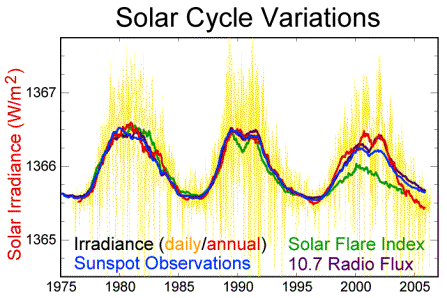Sunspot Cycle and Human Health
For thousands of years, medical practitioners have speculated that human maladies might be correlated with environmental cycles. For example, certain times of the night and certain phases of the moon were thought to be riskier for patients than other times. Modern research, however, has failed to confirm the significance of any such correlations—that is, until just three months ago.
Thanks to two long-term studies in human physiology and pathology, researchers uncovered correlations between human health and the sunspot cycle (see figure 1).1 The research team, headed up by William Hrushesky of the University of South Carolina, first analyzed nearly 1.2 million consecutive, serially independent screening Pap smears from the health records of Dutch women that spanned from January 1983 through December 2003. This screening program included one-third of all adult females living in southern Holland with both urban and rural women of all adult ages fully represented. Here, the team determined the incidence of six infectious, premalignant, and malignant changes in the cervical epithelium. Additionally, the team examined records of physiologic functions (oral temperature, pulse rate, systolic and diastolic blood pressure, respiration rate, and peak expiratory flow) of a healthy man (a biomedical scientist living in St. Paul, Minnesota) measured fives per day throughout the same 21-year period.

In this diagram the vertical scales for irradiance, solar flaring activity, sunspots, and radio flux have been adjusted to permit overplotting on the same vertical axis.
Image credit: Robert A. Rohde/Global Warming Art
The team’s work confirmed results from a previous study,2 which established slightly higher rates of human papilloma virus (HPV), premalignant and malignant cervical changes in Pap smears during the summer months. However, they found no correlations between human health abnormalities and any shorter-term environmental cycles—but they did discover a more significant correlation with the eleven-year sunspot cycle.
For the healthy biomedical scientist, the team noted slight elevations in oral temperature, pulse rate, blood pressure, and respiration rate and a slight decrease in the man’s maximum expiratory flow that peaked several months after the occurrence of solar sunspot maximum. For the Dutch women the researchers detected a similar peak in the six cervical pathologies just after solar maximum.
Solar sunspot maximum happens when solar flaring activity and solar ultraviolet B (UVB) radiation is most intense. The sunspot maximum typically persists for a year or two. Thus, human subjects accumulated the most damage from the higher solar flaring activity and more intense UVB radiation a few to several months after solar sunspot maximum. However, damage from UVB radiation (but not flaring activity) is mitigated by the fact that when such radiation impacts Earth’s stratosphere, it generates more ozone, which, in turn, blocks more of the UVB radiation from reaching the planet’s surface.
Furthermore, the more intense UVB solar radiation also explains the correlation of deleterious cervical changes during the summer months. For predominantly Caucasian women living at latitude 52° north, exposure to solar UVB radiation is considerably greater during the summer months than during winter months. Independent studies demonstrate that UVB radiation activates many viruses,3 including HPV, and also suppresses cellular immune defenses.4
The word “damage” should, perhaps, be in quotes since it took especially meticulous, accurate, and comprehensive medical measurements to even detect the deleterious effects. There is no warrant for any panic over the approaching 2012 solar sunspot maximum.
However, detection of these slightly negative effects does, in part, explain why the Creator chose the specific timing in Earth’s history for creating Adam and Eve. As figure 2 below illustrates, at any earlier or later epoch, humans would have been exposed to far more intense solar flaring activity. The greater the solar flaring activity, the greater the incidence of solar particle, X-ray, and UVB radiation on Earth. While the present era subjects humans to barely detectable medical risks, at any other time those risks would severely limit both human health and longevity.

Image credit for background image: NASA/JPL-Caltech
Like all hydrogen-fusion-burning stars, the Sun exhibits the minimum flaring activity and minimum UVB and X-ray radiation when almost halfway through its hydrogen-fusion burning phase. The Sun, however, is not only at the ideal age for human health and longevity; it is also at the ideal mass. Stars more or less massive display much more intense and variable flaring activity and UVB and X-ray radiation.
The Hrushesky et al. study supports the conclusion that the timing of humanity’s entrance upon the terrestrial scene was no accident of evolution. Only Someone who knows the past, present, and future physics of stars and planets could select the just-right star, place a just-right planet orbiting that star at the just-right distance with the just-right atmosphere, and create humans upon that planet at the just-right time.
Endnotes
- William J. M. Hrushesky et al., “Sunspot Dynamics Are Reflected in Human Physiology and Pathophysiology,” Astrobiology 11 (March 2011): 93–103.
- W. J. Rietveld, M. E. Boon, and J. J. Meulman, “Seasonal Fluctuations in the Cervical Smear Detection Rates for (Pre)malignant Changes and for Infections,”Diagnostic Cytopathology 17 (December 1997): 452–55; W. J. Hrushesky et al., “Season, Sun, Sex, and Cervical Cancer,”Cancer Epidemiology Biomarkers & Prevention 14 (August 2005): 1940–47; Hrushesky et al., “Sun Exposure, Sexual Behavior, and Uterine Cervical Human Papilloma Virus,”International Journal of Biometeorology 50 (January 2006): 167–73.
- Evan R. Taylor et al., “UVB Radiation Reduces the Half-Life and Transactivation Potential of the Human Papillomavirus 16 E2 Protein,”Oncogene 22 (July 17, 2003): 4469–77.
- W. Goettsch et al., “UV-B and the Immune System. A Review with Special Emphasis on T-Cell Mediated Immunity,”Thymus 21 (March 1993): 93–114; J. D. Bos, “The Skin as an Organ of Immunity,”Clinical & Experimental Immunology 107, Supplement 1 (January 1997): 3–5; M. K. Selgrade, M. H. Repacholi, and H. S. Koren, “Ultraviolet Radiation-Induced Immune Modulation: Potential Consequences for Infectious, Allergic, and Autoimmune Disease,”Environmental Health Perspectives 105 (March 1997): 332–34.






